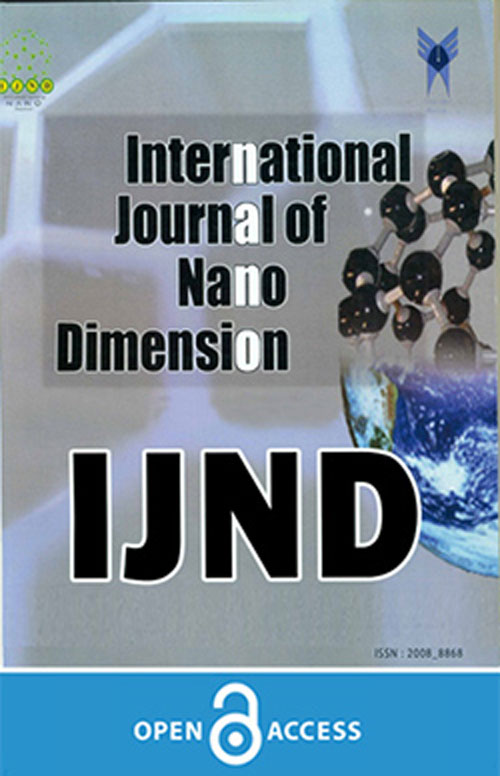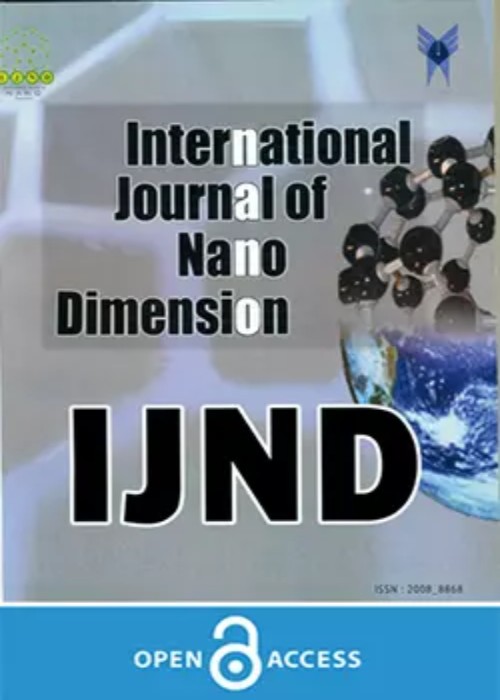فهرست مطالب

International Journal of Nano Dimension
Volume:8 Issue: 1, Winter 2017
- تاریخ انتشار: 1395/12/25
- تعداد عناوین: 10
-
-
Pages 1-8The ground state energies of two interacting electrons confined in a coupled double quantum dot (DQD) presented in a magnetic field has been calculated by solving the relative Hamiltonian using variational and exact diagonalization methods. The singlet-triplet transitions in the angular momentum and spin of the quantum dot ground state had been shown .We have studied the magnetic field versus confining frequency and magnetic field versus potential barrier height phase diagram of DQD .Furthermore, we have investigated the dependence of the exchange energy of two electron double quantum dot on the confining frequency, potential height barrier, barrier width and magnetic field strength. The comparisons show that our results are in very good agreement with reported works.Keywords: Double quantum dot, Exact diagonalization, Exchange energy, Magnetic field, Variational method
-
Development and evaluation of bio-nanoparticles as novel drug carriers for the delivery of DonepezilPages 9-17The purpose of the present study was to formulate and evaluate donepezil loaded bio-nanoparticles for effective treatment of Alzheimers disease. For the preparation of bio-nanoparticles biomaterial was isolated from fruits of Carica papaya by an economic method. The biomaterial recovered from the concentrate was subjected for various physicochemical properties like color, solubility, color changing point and chemical test. Bio-nanoparticles were prepared by modified nanoprecipitation method in different batches with variable drug/biomaterial ratio. Prepared batches were subjected for various evaluation studies like particle size, zeta potential, scanning electron microscopic studies, transmission electronmicroscopy, surface entrapment, in-vitro diffusion, differential scanning calorimetry and stability. Particle size and zeta potential result revealed that all nanoformulation were within range of 1.808 to 995.1 with slight negative in charge. Scanning electron microscopy and transmission electronmicroscopy report indicate that formulations were spherical in shape with less or no aggregation. Less surface entrapment leads to better drug entrapped inside nanomatrix. Bio-nanoformulations were capable of releasing the drug in a slow sustained manner. From the present investigation, it may be concluded that biomaterial isolated from fruits of Carica papaya used in the preparation of bio-nanoparticle act as an efficient carriers for deliver donepezil at a controlled rate and may significantly improve the ability to cross blood-brain barrier.Keywords: Bio, nanoparticle, Diffusion study, Donepezil, Modified nanoprecipitation method, Stability study
-
Pages 18-30A nanofluid is mixture of nano sized particles and a base fluid. This paper investigates by using laboratory based double pipe heat exchanger model, the performance of nanofluid containing about 48.46nm particle size nanoparticles (ZnO) without or with addition of nonionic surfactant Rokanol K7 (500ppm) into the base fluid double distilled water to prepared three different concentrations 1.0%, 2% and 3% (v/v) of ZnO-water or ZnO-RK7. Effects of temperature and concentration of nanoparticles on viscosity and heat transfer coefficient in heat exchanger are investigated. The experimental results shows that the viscosity of nanofluids increased with increasing concentration of fluid whereas decreased with increasing temperature from 20 to 60ºC. However, it has been also observed that heat transfer coefficient increases with the operating temperature and concentration of nanoparticles. The conclusion derived for the study is that overall heat transfer coefficient enhanced with increasing concentration upto 3% of ZnO-RK7 as compared to without surfactant nanofluids.Keywords: Heat exchanger, Heat transfer coefficient, Nanofluid, Nonionic surfactant, Viscosity
-
Pages 31-39Poly (amide-6-b-ethylene oxide)/Zinc Oxide (PEBA/ZnO) mixed matrix membranes were fabricated using ethanol/water as solvent by solvent casting method. The concentration of ZnO in membrane was set to 0.1 wt.% and the synthesized membranes were characterized by AFM and FTIR. Effects of ZnO nanoparticle on CO2, CH4 and N2 permeabilities, and CO2/N2 and CO2/CH4 selectivities of the membranes were investigated at the ambient temperature and pressure range of 412 bar. The results revealed that the CO2 permeability of the nano-composite membrane increased 158 % with pressure, from 54.08 barrer (at 4 bar) to 139.59 barrer (at 12 bar). Furthermore, CO2 permeability for the nano-composite membrane was higher than neat polymeric membrane. The PEBA/ZnO nano-composite membranes thus provide a promising potential for CO2/N2 and CO2/CH4 separation.Keywords: CO2 permeation, Gas separation, Mixed matrix membrane, PEBA, Nano, composite, ZnO
-
Pages 40-48Quantum-dot cellular automata (QCA) are an emerging technology and a possible alternative for faster speed, smaller size, and low power consumption than semiconductor transistor based technologies. Previously, adder designs based on conventional designs were examined for implementation with QCA technology. This paper utilizes the QCA characteristics to design a fault-tolerant adder that is more powerful in terms of implementing robust digital functions. By considering two-dimensional arrays of QCA cells, fault properties of such block adder can be analyzed in terms of misalignment, missing and dislocation cells. In order to verify the functionality of the proposed device, some physical proofs are provided. The results confirm our claims and its usefulness in designing digital circuits.Keywords: Adder, Design, modeling, Fault, tolerant circuits, Nanoelectronic circuits, Quantum, dot Cellular Automata
-
Pages 49-60In this research, silver nanoparticles (Ag NPs) were prepared by a low-cost, rapid, simple and ecofriendly approach using Grape fruit extract as a novel natural reducing and stabilizing agent. The product was characterized by UV-visible spectroscopy, X-ray diffraction (XRD), Fourier transform infrared spectroscopy (FTIR), field emission scanning electron microscopy (FESEM), energy-dispersive X-ray (EDX) spectroscopy and transmission electron microscopy (TEM). The reaction conditions including time, content of reducing agent and silver nitrate, temperature and pH were investigated. The optimum yield of Ag NPs was obtained when 10 mM of silver nitrate was reacted with 9 mL of Grape fruit extract at pH = 9 and heated it to 55 oC within 25 minutes. The crystalline nature of Ag NPs was confirmed from XRD analysis. SEM and TEM images showed that the obtained Ag NPswere spherical in shape and their sizes were in the range of 25-85 nm. EDX analysis confirmed presence of the elemental silver. On the basis of FT-IR analysis, it can be stated that the hydroxyl, carbonyl and carboxyl functional groups present in bio-molecules of Grape fruit extract are responsible for the reduction of Ag ions and stabilization of the obtained Ag NPs. The biosynthesized Ag NPs showed good antimicrobial activity against Gram-positive (Bacillus cereus, Staphylococcus aureus, Staphylococcus epidermidis) and Gram-negative (Escherichia coli, Klebsiella pneumoniae)bacteria. In addition, the catalytic activity of the Ag NPs wasstudied for the reduction of nitro compounds by using NaBH4.Keywords: Phyto-synthesis, Silver nanoparticles, Grape fruit extract, antibacterial activity, Nitro reduction, Catalyst
-
Pages 61-69Nanotechnology provides the ability to engineer the properties of materials by controlling their size, and this has driven research toward a multitude of potential uses for nanomaterials. This study aimed at biosynthesis and characterization of silver nanoparticles (SNPs) using exopolysaccharides (EPS) of lactic acid bacteria (LAB) and the antimicrobial potential of the biosynthesized SNPs against some pathogenic bacteria. EPS production by the EPS- producing Lactobacillus casei (LPW2E) and Lactobacillus fermentum (LPF6) using submerged fermentation ranged from 256 - 640.9 mg/L. The EPS produced by the two LABs were used for the biosynthesis of SNPs. The SNPs were characterized by colour changes from colourless to yellowish brown and deep brown after 24hrs of incubation. The UV-visible spectrophotometer was further used to characterize the SNPs. The SNPs had strong surface plasmon resonance band at 500nm. Scanning electron microscopic (SEM) analysis showed that the SNPs varied in shape and were partially aggregated. The particle size ranged from 0.210nm and 0.010nm. The FTIR analysis indicated the presence of functional groups such as hydroxyl, carboxyl, ester, aldehydes among others which may be responsible for the reduction, capping, and stabilization of the SNPs. The SNPs had antibacterial activity against the test pathogens and the zones of inhibition ranged between 12 - 26mm. In conclusion, this study demonstrated that EPS could be used for the production of stable SNPs with antibacterial activity.Keywords: Exopolysaccharides, FTIR, Lactic acid bacteria, SEM, Silver nanoparticles
-
Pages 70-81In this article free vibration of a Timoshenko nanobeam with variable cross-section is investigated using nonlocal elasticity theory within the scope of continuum mechanics. Small scale effects are modelled after Eringens nonlocal elasticity theory while the non-uniformity is presented by exponentially varying width through the beam length with constant thickness. Analytical solution is achieved for both Timoshenko beams and nanobeams with different boundary conditions including both ends being simply-supported (S-S), both ends being clamped (C-C) and one end clamped other free (C-F). It is shown that section variation accompanying small scale effects has a noticeable effect on natural frequencies of non-uniform Timoshenko beams at nano-scale. In order to illustrate these effects, Natural frequencies of single-layered graphene nano-ribbons (GNRs) with various boundary conditions are obtained for different nonlocal and non-uniform parameter which shows a great sensitivity to non-uniformity in different shape modes.Keywords: Free vibration, Timoshenko beam, Analytical solution, Nonlocal, Nanobeam, Variable cross-section
-
Pages 82-88Single-walled carbon nanotubes (SWCNTs) have a great deal of attention due to their unique properties. These properties of SWCNTs can be used in various devices such as nanosensors. SWCNTs nanosensors have fast response time and high sensitivity to special gas molecules which is very favorable for important applications. Recently, gas adsorption over outer surface of SWCNTs nanosensors was arguably a very interesting theoretical study. Here, the sensing capability of (6,0) SWCNTs for adsorption H2, N2, O2 and CO molecules are studied.Thegeometry optimization, electronic, thermodynamic, and vibrational properties have been investigated. All the calculations are based on the density functional theory (DFT) at the B3LYP/6-31G level through the Gaussian 09W program package. It is found that, adding these molecules to SWCNT causing a small increase in the bond lengths, and an increase in the total energy. In IR spectra, it is observed increasing the vibration modes and higher stretching vibration wave numbers of SWCNT with the studies molecules. This work confirms that (6,0) SWCNT can be used as nanosensor, and using DFT investigations, it is possible to obtain much more data to apply in medical science and industrial technologies.Keywords: Adsorption energy, DFT, IR spectra, Sensing capability, SWCNT
-
Cyclic voltammetry of bulk and nano manganese sulfate with Doxorubicin using glassy Carbon electrodePages 89-96The cyclic voltammetry of both bulk manganese sulfate (BMS) and nano manganese sulfate (NMS) were studied using 0.1M KCl supporting electrolyte and glassy carbon working electrode. The redox behavior for both bulk (BMS) and MnSO4 (NMS) sulfate was studied voltammetrically in presence and absence of Doxorubicin (DR) using three electrodes system, silver- silver chloride (Ag/AgCl), platinum and glassy carbon electrodes. Various scan rates were studied for the redox behaviors for bulk and nano MnSO4 (NMS) alone or in presence of Doxorubicin (DR). Stability constants for the interaction of manganese ions with Doxorubicin (DR) were evaluated. The redox mechanism was discussed.Keywords: Cyclic voltammetry, Doxorubicin (DR), Manganese sulfate, Redox mechanism, Glassy carbon electrode


